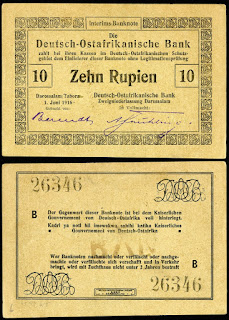The German East Africa Company originated in 1884, with the aim of trading in Africa with present day Tanzania, Burundi and Rwanda. A revolt along the coast of what is now Tanzania in 1889 led to intervention by the German navy. The Company was sold to the German government which began to rule German East Africa (GEA). Thus, was created German East Africa (1885-1918) which included present day Burundi, Rwanda, Tanzania mainland and the Kionga triangle of Mozambique.
Coat of Arms
It ended with Imperial Germany's defeat in World War I. Ultimately, German East Africa was divided between Britain, Belgium and Portugal and was reorganized as a mandate of the League of Nations.
The rupee was the major silver coin in India and on the Indian subcontinent. Being a popular trade coin, the rupee reached the shores of East Africa in the 19th century. When the German colonial armies came there and found a well-established rupee currency used since the second half of the 19th century, which was preferred to the American dollar and the Maria Theresa Thaler. Initially the administration of German East Africa lay in the hands of German East African Company. The company did not change the existing currency, but quite contrary, started to issue rupee itself. The German colonial coins were minted in Berlin and shipped to Africa. The obverse depicted the German Emperor Wilhelm II (1888-1918), while the reverse bore the coat of arms of the German East African Company, a lion under a coconut tree.
The Rupie was the currency of German East Africa between 1890 and 1916, continuing to circulate in Tanganyika Territory until 1920.
The Rupie was initially equivalent to the Indian rupee. In 1890, silver one- and two-rupee coins were introduced, followed the next year by silver quarter and half rupee coins Until 1904, it was divided into 64 Pesa. The currency was decimalized on 28 February 1904, with one-rupee equivalent to100 Heller. At the same time, a fixed exchange rate of 15 Rupien equal to 20 German Mark was established.
In 1905, the Deutsch-Ostafrikanische Bank introduced notes for 5, 10, 50 and 100 Rupien and in 1912 for 500 Rupien
5 Rupien
10 Rupien
50 Rupien
In 1915 and 1916 during World War I, a large series of emergency issues of paper money were issued.
1 Rupie
5 Rupien
10 Rupien
20 Rupien
1916 also saw a final issue of coins to pay German led troops, including 15 Rupien coins which contained an equal amount of gold to equal 15 German Marks. The rupee was replaced in 1920.


















No comments:
Post a Comment
Any inputs or feedback is welcome!